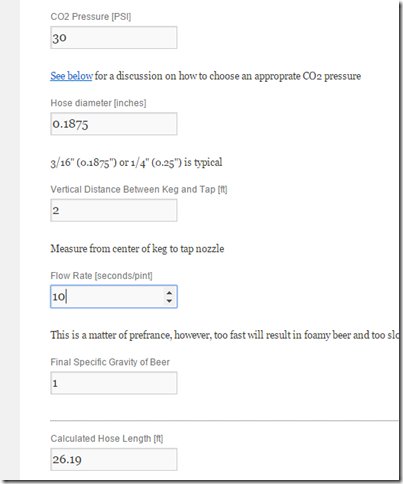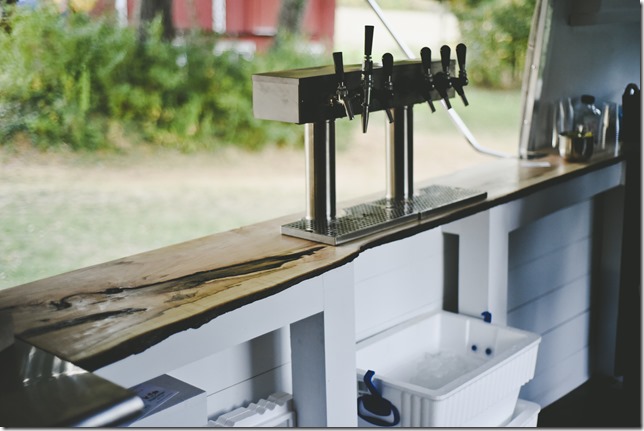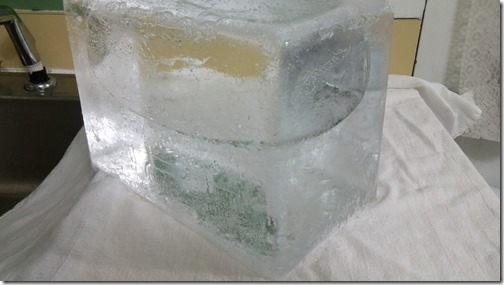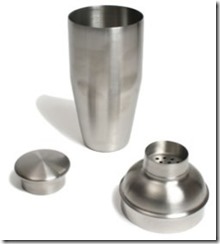Let’s say you’re a bar or a really enthusiastic home drinker and want to serve cocktails on draft. You’re wondering what it takes, money-wise, to get into the whole kegging thing. If there’s one thing I’ve gotten a lot of experience with over the last few years it’s kegging cocktails, so I thought I’d share some tips.
I’m going to recommend you don’t go the cheap route. I had initially included cheap components in my barebones carbonating cocktails post. I regret it. Every time I’ve tried to save money by buying something less than I really wanted, I ended up replacing it later, sometimes because it broke, sometimes because it sucked and I needed something better. I’ve talked to several people who’ve said the same. So here’s what I think you should get.
Necessities
Tank: $50.
 Find your local gas supply store and pick up a used tank from them. They’re cheaper that way. I think I got a 10 lb. tank for $50 last time, whereas a new one is $90. If you buy from the supply store, they’ll often let you just swap tanks later for convenience, so you’ll not have to worry about getting them recertified (which you’d otherwise have to do every 5 years for about $30). You also won’t have to drop it off then come back a day or two later to pick it up, you just walk in and swap it like exchanging propane at the gas station.
Find your local gas supply store and pick up a used tank from them. They’re cheaper that way. I think I got a 10 lb. tank for $50 last time, whereas a new one is $90. If you buy from the supply store, they’ll often let you just swap tanks later for convenience, so you’ll not have to worry about getting them recertified (which you’d otherwise have to do every 5 years for about $30). You also won’t have to drop it off then come back a day or two later to pick it up, you just walk in and swap it like exchanging propane at the gas station.
They’ll be a lot cheaper to fill than at the local homebrew store (LHBS) too. Usually the LHBS is buying from the gas supplier and reselling at 2-3x the cost. (They’re also using a different method to fill the tank that is faster but fills it less, so you end up paying for CO2 you aren’t even getting!) Google for dry ice in your area, the local dry ice seller probably does tank swaps. I hear welding shops do too but have never been to one.
I’d get at least a 10 lb. tank. They’re only slightly more than a 5 lb. tank, and of course hold twice as much. For home use these last me quite awhile, however for my commercial stuff I blow through 10 lbs. for a good-sized event so I use a bigger tank.
Regulator w/cage: $85
 Get a good dual gauge regulator. It’s like $10 or $20 more than a cheap one. If you get the cheap one, you’re going to replace it later. I promise. I got the crappy Kegco I recommended in my first post for $45 on Amazon and it was the first thing that bit the dust. (Should have known from its 3.5 star reviews.) A crappy one is also going to require a wrench to adjust, whereas a good one can be adjusted by hand.
Get a good dual gauge regulator. It’s like $10 or $20 more than a cheap one. If you get the cheap one, you’re going to replace it later. I promise. I got the crappy Kegco I recommended in my first post for $45 on Amazon and it was the first thing that bit the dust. (Should have known from its 3.5 star reviews.) A crappy one is also going to require a wrench to adjust, whereas a good one can be adjusted by hand.
I love the Micromatic 642, pictured here. (I’ve only used a few, but it’s the best so far.) I’ve also got a couple of the dual regulators for when I need to set two different pressures. For bar service you’re probably going to want at least two different pressures available.
Get a gauge cage (or two if you go with the dual regulator). You’re going to have your tank tip over sooner or later, I promise. This will save it from busting a gauge and pay for itself quickly. I’ve had to replace gauges, they are very fragile.
You can do a double regulator on a ten pound CO2 tank, but it’s precariously balanced when full and a serious tipping hazard. Make sure to strap the tank in place. With a 5 lb. it won’t even stand up by itself. A 20 lb. is no problem even for a dual regulator, but still can be tipped so get the cage.
Perlick Adjustable Tap/Shank ($80)
 These puppies aren’t cheap but boy are they worth it. Without them you have to use line length calculators and match the length of the line to the PSI of what you want to serve. If you’re just doing beer it’s not as bad. A lot of home brewers say they just serve everything at 12 PSI. I don’t do this, even with my beer, because some beer tastes better with more carbonation than others. If you want to be able to change your pressure you either need a flow control faucet or to be constantly swapping out the line.
These puppies aren’t cheap but boy are they worth it. Without them you have to use line length calculators and match the length of the line to the PSI of what you want to serve. If you’re just doing beer it’s not as bad. A lot of home brewers say they just serve everything at 12 PSI. I don’t do this, even with my beer, because some beer tastes better with more carbonation than others. If you want to be able to change your pressure you either need a flow control faucet or to be constantly swapping out the line.
If you’re doing cocktails you’re doing high PSI, and they can vary a bit more widely. (1) You need to either get an adjustable faucet or be constantly changing lines. If you want to serve different drinks at different pressures, and you probably will, you’ll want these.
Gas Line
As far as I can tell, gas line is just gas line. I usually buy whatever’s cheapest and I’ve never had any problems with any of it. Just do some rough math as to how far you want to run the line, then add a few feet in for good measure and you’re done.
Beer Line
 Beer line lengths are a little trickier. Use a line length calculator to figure out proper pressure. Set your Specific Gravity to 1. Set your PSI to the lowest you’d carbonate anything at, which is probably around 30. If you followed my recommendation and got flow control faucets, then make the line a bit shorter than it says.
Beer line lengths are a little trickier. Use a line length calculator to figure out proper pressure. Set your Specific Gravity to 1. Set your PSI to the lowest you’d carbonate anything at, which is probably around 30. If you followed my recommendation and got flow control faucets, then make the line a bit shorter than it says.
If the number that pops out is shorter than your run, you have to use line with a higher Internal Diameter (ID). The homebrew standard is 3/16” line.
You can see on the right, using some assumptions I made, I need 26 feet of line between each keg and the tap. Or, I could just get good flow control faucets and run very little. In my camper I’m serving at 40 psi on 12 feet of line and thanks to flow control I have no foaming.
Niceties
Manifolds.
 I’m not counting the price on here, because they’re only necessary if you’re distributing gas. A manifold basically lets you distribute gas (at the same pressure) from one regulator to multiple kegs. This is quite useful if you are serving more than one thing at a given pressure, as it’s far cheaper than having a separate regulator for each. A homebrewer with a keezer might want a 2-way. A bar might go way more. If, like me, you’re doing several carbonated cocktails on draft, you can probably run them all off of one regulator with a big enough manifold. (I still have 3 of this 3-way manifold in the camper though because beer comes out at lower PSI and shaken drinks at higher, often with nitrogen. I can configure my 6 taps in very many different ways as a result.) I use 6-way manifolds when carbonating because I have to do a lot of kegs at once sometimes.
I’m not counting the price on here, because they’re only necessary if you’re distributing gas. A manifold basically lets you distribute gas (at the same pressure) from one regulator to multiple kegs. This is quite useful if you are serving more than one thing at a given pressure, as it’s far cheaper than having a separate regulator for each. A homebrewer with a keezer might want a 2-way. A bar might go way more. If, like me, you’re doing several carbonated cocktails on draft, you can probably run them all off of one regulator with a big enough manifold. (I still have 3 of this 3-way manifold in the camper though because beer comes out at lower PSI and shaken drinks at higher, often with nitrogen. I can configure my 6 taps in very many different ways as a result.) I use 6-way manifolds when carbonating because I have to do a lot of kegs at once sometimes.
I recommend getting one with check valves. I made the mistake of not having them originally, and learned the hard way that that is a great way to get liquid to back up through the gas line. Then you have to clean everything out and dry it to avoid mildew, and you also might get product from one keg going through the gas tube and into another while shaking.(2)
Also, for safety, I highly recommend getting ones with pressure relief valves. Especially if you’re doing something with some particulate matter in it, like an unfiltered beer. I don’t think there’s really much chance of one exploding, and you’ve got relief valves on your kegs and regulators, but better safe than sorry.
Stainless Ball Lock Disconnects
 If you’re kegging cocktails, you’re probably using homebrew Corny kegs. The standard homebrew disconnects are made from plastic. These break. Like all the time. The last thing you want is to be changing over a keg mid-service and have your disconnect break on you.
If you’re kegging cocktails, you’re probably using homebrew Corny kegs. The standard homebrew disconnects are made from plastic. These break. Like all the time. The last thing you want is to be changing over a keg mid-service and have your disconnect break on you.
I love my stainless disconnects. They don’t break. I stepped on a plastic one once and it broke and lodged a chunk of plastic in my shoe sole. I accidentally ran a stainless one over with my Airstream and after I dug it out of the ground it still worked.
Another advantage, if you use the Liquid Bread Carbonater, it was redesigned to not allow the ball lock disconnect to stay on, which makes it a huge pain in the dick to use. (The old red ones were not like that, the new blue ones won’t allow it. If you don’t already own the liquid bread, I highly prefer the newer stainless ones as a result, but if you’re like me you’ve probably got a few of the old ones kicking around.) A stainless disconnect will clamp on to any of them.
Also, some of the stainless ones come with an MFL connector rather than a hose barb. That’s useful if you need to use line with a larger ID than 1/4”. (Which would be rare.)
If you have any questions about any of this, feel free to drop it in the comment section. In my next post I’ll give you a great couple recipes.
Notes
1. In Liquid Intelligence, Dave Arnold recommends the pre-mix soda valves by C.M. Becker. I called them when I was building the camper and had them make me four of them. I can’t say enough good things about that company’s customer service. The owner himself got on the phone with me and made me what I needed. That kind of thing doesn’t happen much these days.
Unfortunately the quality of service is much better than the quality of the valves themselves. The shanks were a pain in the ass to install in my beer tower. They’re just a tiny amount larger than a normal beer shank, so getting them in without stripping the threads with a wrench was a bitch. The nut/hose barb at the end leaked like crazy and I had to use PTFE tape and plumber’s putty, something I’ve not experienced on the several beer shanks I’ve used. Even then it was a pain to get to seal properly.
And worse the product is unreliable. It’s made of a chintsy plastic, rather than stainless. Even if you don’t worry about plastic touching your high alcohol, high acid cocktails, they just look bad. But I’d deal with that if they worked ok.
Unfortunately they do not. They have a flow adjustment valve on the side, but it’s odd. It rotates all the way around (the Perlick only rotates maybe 180 degrees) so it’s hard to tell where you’re at, and it doesn’t seem to do much regardless. I constantly experience dripping. I can have three faucets hooked up to three kegs that have the same pressure and get a trickle out of one, a torrent out of another, and the middle one be just right.
The one that’s just right will be incredible though. You can pour a highly carbonated ginger beer out at 32 PSI and see no foam at all. When they work they do a better job of keeping the bubbles in than a Perlick, but they just aren’t reliable enough for service.
2. For instance I was once force-carbing a couple sodas. I had shut off the gas at the regulator, but left all the ports on the manifold open and vented all of the kegs. When I shook one keg, the higher pressure in it forced the soda through the gas line, through the manifold, and into another keg. Thankfully they were the same soda so the product wasn’t damaged, but it’s a bitch to disassemble your setup, disassemble the manifold, then force cleaner through the whole thing.
Also for my launch party I had left the gas on in the camper as we drove to the event. Big mistake! The shaking caused by bumps in the road flooded all of my gas lines with a mix of six different cocktails/mixers/beers. Gross! I didn’t realize what had happened until days later, and the manifold and gas lines were so gross I just threw them out.

 Get a good dual gauge regulator. It’s like $10 or $20 more than a cheap one. If you get the cheap one, you’re going to replace it later. I promise. I got the crappy Kegco I recommended in my first post for $45 on Amazon and it was the first thing that bit the dust. (Should have known from its 3.5 star reviews.) A crappy one is also going to require a wrench to adjust, whereas a good one can be adjusted by hand.
Get a good dual gauge regulator. It’s like $10 or $20 more than a cheap one. If you get the cheap one, you’re going to replace it later. I promise. I got the crappy Kegco I recommended in my first post for $45 on Amazon and it was the first thing that bit the dust. (Should have known from its 3.5 star reviews.) A crappy one is also going to require a wrench to adjust, whereas a good one can be adjusted by hand. 


 If you’re kegging cocktails, you’re probably using homebrew Corny kegs. The standard homebrew disconnects are made from plastic. These break. Like all the time. The last thing you want is to be changing over a keg mid-service and have your disconnect break on you.
If you’re kegging cocktails, you’re probably using homebrew Corny kegs. The standard homebrew disconnects are made from plastic. These break. Like all the time. The last thing you want is to be changing over a keg mid-service and have your disconnect break on you. 

























